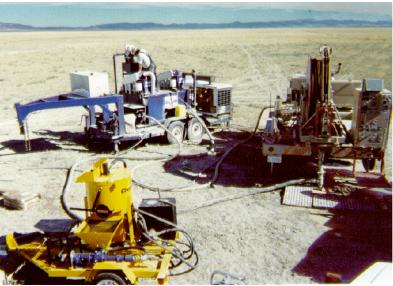- Further developed and evaluated an existing concept for a coiled-tubing-deployed microdrilling system using modeling, laboratory tests, and shallow field demonstrations,
- Identified key technologies needed to downsize existing equipment and develop new equipment to drill microholes to depths of 5000 feet, and
- Prepared a Road Map for a $20-million, multi-year technology-development program that proposes to demonstrate prototype rotary coiled-tubing-deployed microdrilling equipment capable of reaching 5000 feet and evaluates the possibility of expanding to percussion and air drilling.
In 1994, Los Alamos National Laboratory (LANL) advanced a concept for drilling holes with diameters from 1-3/8-inches to 2-3/8-inches This concept for coiled-tubing-deployed microdrilling evolved from theoretical studies and lab tests, to field demonstrations in which 1-3/4- and 2-3/8-in.-diameter holes were drilled. The LANL coiled-tubing-deployed microhole drilling concept may provide a method to greatly reduce the cost of drilling shallow- and moderate-depth holes for exploration, long-term monitoring, and limited production service. The availability of small sensors and telemetry instrumentation to mine information from microholes has changed the paradigm since slimhole-drilling development reached it peak.
The concept developed by LANL avoids the more complicated aspects of conventional drilling and reduces the size of the rig required. The coiled-tubing-deployed drill was selected to provide inexpensive, reliable, hard-wired, bottom-hole data and control telemetry. The basic, built-for-purpose coiled-tubing-unit (CTU) microrig is readily adaptable to support low-cost directional drilling and through-tubing micro-lateral drilling from existing wells. The drilling system will also be suitable for drilling with low density, compressible drilling fluids to penetrate depleted reservoirs, and to search for and produce bypassed oil and gas.
The LANL concept assumes that a properly designed, polycrystalline diamond compact (PDC) or thermally stable, polycrystalline diamond (TSD) drag bit will be rotated by a relatively high speed Moineau-principle, positive-displacement (drilling) motor (PDM). A robust, instrumented, near-bit-sensor sub located below the motor will support the automation and control of the bottom-hole drilling assembly. An isolation sub above the motor will protect a less robust telemetry instrumentation sub and the coiled tubing from pulsations and vibrations generated in the drilling assembly.
The LANL coiled-tubing-deployed microdrilling concept was successfully demonstrated at three sites: the Fenton Hill demonstration site near Los Alamos, a site with dry-lake-bed sediments, and the San Ysidro site in Sandoval County, NM. Based on local outcrops, it was anticipated that the San Ysidro site would provide the first application of the LANL microdrilling system to typical oil-field rocks. As it turned out, the site provided significant challenges including artesian flow, loss of returns, and severe well instability in poorly consolidated sediments, but did not provide the anticipated strata of relatively hard sandstones and shale. Problems were encountered with excessive hole washouts at the San Ysidro site, but it is believed that the development of a low-flow, high-differential-pressure drilling motor, and the stability of continuous drilling operations (rather than nightly shutdowns), will mitigate the problems.
Los Alamos presently has the capability to drill 1-3/4-inch and 2-3/8-inch holes up to 800 feet deep in unconsolidated and soft sediments with commercial PDMs. LANL can complete the holes with a cemented-in casing in stable formations, and have demonstrated the installation of casing in unstable formations with a bentonite grout.
Based on these demonstrations, modifications needed to improve the original concept have been identified. The modifications are described in a Road Map document that outlines the technologies needed to develop a capability to reach a depth of 5000 ft with a low-cost, high-performance drilling system. The advances are needed in three areas: (1) optimization of drilling hydraulics, cuttings transport, and bore-wall stabilization; (2) enhancement of drilling motors and rotary percussion hammers with compatible isolation tools; and (3) downsizing downhole sensors, instrumentation, and telemetry needed to support automated drilling, real-time steering, and logwhile-drilling. Technology requirements for microhole completions include downsizing perforation technology, and downhole cementing equipment for both coupled casing and continuous (coiled-tubing) casing.




